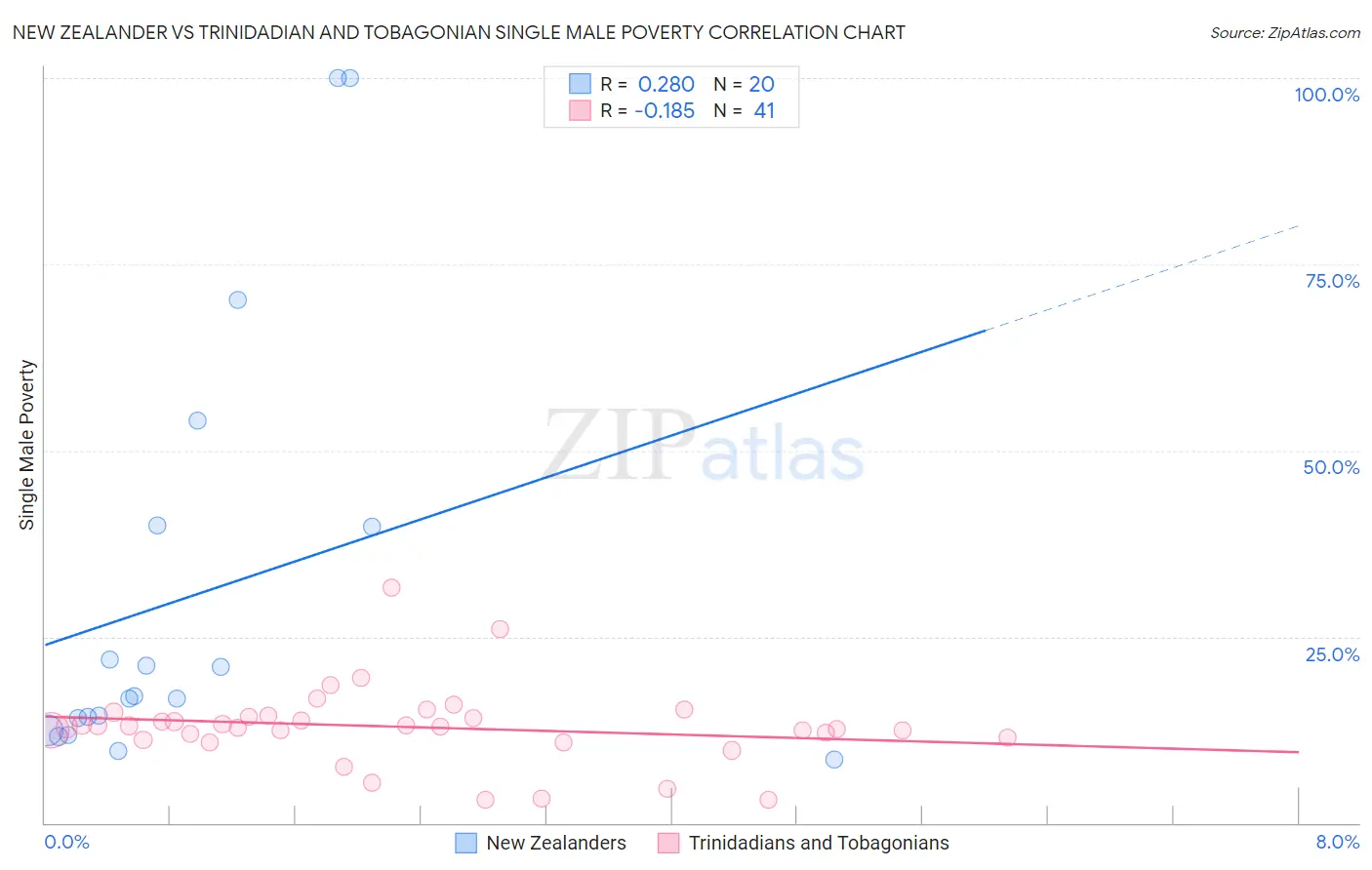New Zealander vs Trinidadian and Tobagonian Single Male Poverty
COMPARE
New Zealander
Trinidadian and Tobagonian
Single Male Poverty
Single Male Poverty Comparison
New Zealanders
Trinidadians and Tobagonians
13.2%
SINGLE MALE POVERTY
10.7/ 100
METRIC RATING
221st/ 347
METRIC RANK
13.0%
SINGLE MALE POVERTY
21.4/ 100
METRIC RATING
201st/ 347
METRIC RANK
New Zealander vs Trinidadian and Tobagonian Single Male Poverty Correlation Chart
The statistical analysis conducted on geographies consisting of 101,681,215 people shows a weak positive correlation between the proportion of New Zealanders and poverty level among single males in the United States with a correlation coefficient (R) of 0.280 and weighted average of 13.2%. Similarly, the statistical analysis conducted on geographies consisting of 204,213,293 people shows a poor negative correlation between the proportion of Trinidadians and Tobagonians and poverty level among single males in the United States with a correlation coefficient (R) of -0.185 and weighted average of 13.0%, a difference of 1.1%.

Single Male Poverty Correlation Summary
| Measurement | New Zealander | Trinidadian and Tobagonian |
| Minimum | 8.6% | 3.0% |
| Maximum | 100.0% | 31.6% |
| Range | 91.4% | 28.6% |
| Mean | 30.8% | 12.9% |
| Median | 16.9% | 13.0% |
| Interquartile 25% (IQ1) | 13.3% | 11.3% |
| Interquartile 75% (IQ3) | 39.9% | 14.4% |
| Interquartile Range (IQR) | 26.6% | 3.1% |
| Standard Deviation (Sample) | 28.6% | 5.3% |
| Standard Deviation (Population) | 27.9% | 5.2% |
Demographics Similar to New Zealanders and Trinidadians and Tobagonians by Single Male Poverty
In terms of single male poverty, the demographic groups most similar to New Zealanders are Central American (13.2%, a difference of 0.020%), Immigrants from Burma/Myanmar (13.1%, a difference of 0.24%), Scandinavian (13.1%, a difference of 0.27%), Bermudan (13.1%, a difference of 0.29%), and Austrian (13.1%, a difference of 0.39%). Similarly, the demographic groups most similar to Trinidadians and Tobagonians are Basque (13.0%, a difference of 0.060%), Immigrants from Bangladesh (13.0%, a difference of 0.090%), Estonian (13.0%, a difference of 0.090%), Polish (13.0%, a difference of 0.17%), and Northern European (13.0%, a difference of 0.21%).
| Demographics | Rating | Rank | Single Male Poverty |
| Trinidadians and Tobagonians | 21.4 /100 | #201 | Fair 13.0% |
| Basques | 20.7 /100 | #202 | Fair 13.0% |
| Immigrants | Bangladesh | 20.4 /100 | #203 | Fair 13.0% |
| Estonians | 20.3 /100 | #204 | Fair 13.0% |
| Poles | 19.3 /100 | #205 | Poor 13.0% |
| Northern Europeans | 18.9 /100 | #206 | Poor 13.0% |
| Sudanese | 17.7 /100 | #207 | Poor 13.1% |
| Immigrants | Western Africa | 17.6 /100 | #208 | Poor 13.1% |
| Mexican American Indians | 17.5 /100 | #209 | Poor 13.1% |
| Immigrants | Haiti | 16.8 /100 | #210 | Poor 13.1% |
| Swedes | 16.8 /100 | #211 | Poor 13.1% |
| Senegalese | 16.4 /100 | #212 | Poor 13.1% |
| Italians | 15.9 /100 | #213 | Poor 13.1% |
| Zimbabweans | 14.9 /100 | #214 | Poor 13.1% |
| Japanese | 14.8 /100 | #215 | Poor 13.1% |
| Austrians | 13.9 /100 | #216 | Poor 13.1% |
| Bermudans | 13.0 /100 | #217 | Poor 13.1% |
| Scandinavians | 12.9 /100 | #218 | Poor 13.1% |
| Immigrants | Burma/Myanmar | 12.6 /100 | #219 | Poor 13.1% |
| Central Americans | 10.9 /100 | #220 | Poor 13.2% |
| New Zealanders | 10.7 /100 | #221 | Poor 13.2% |